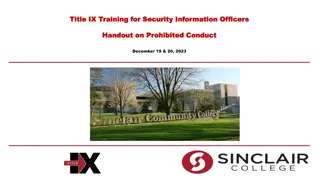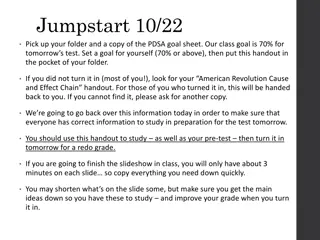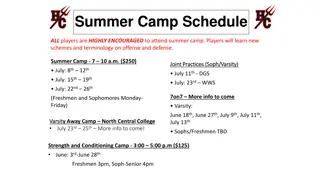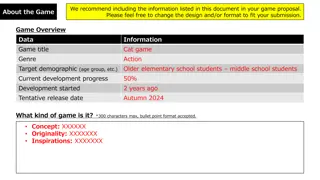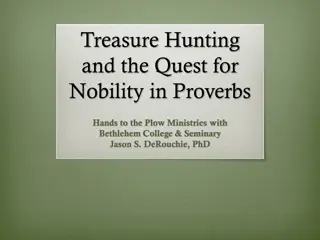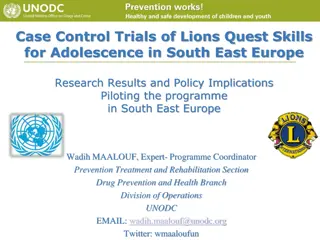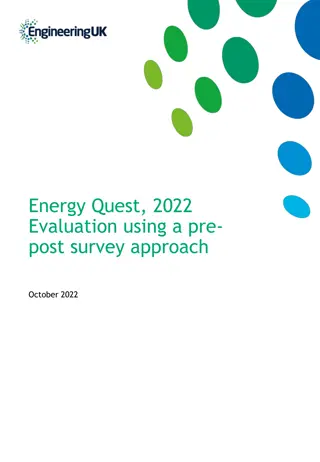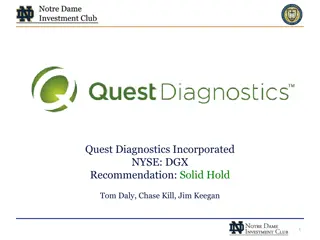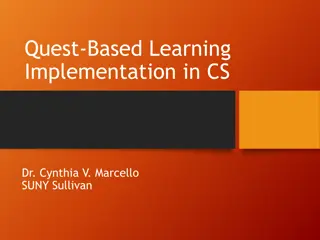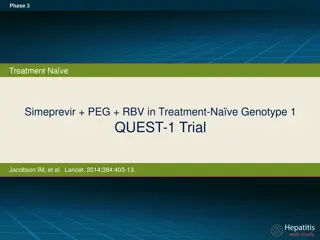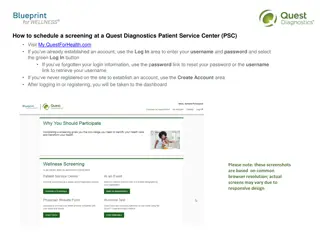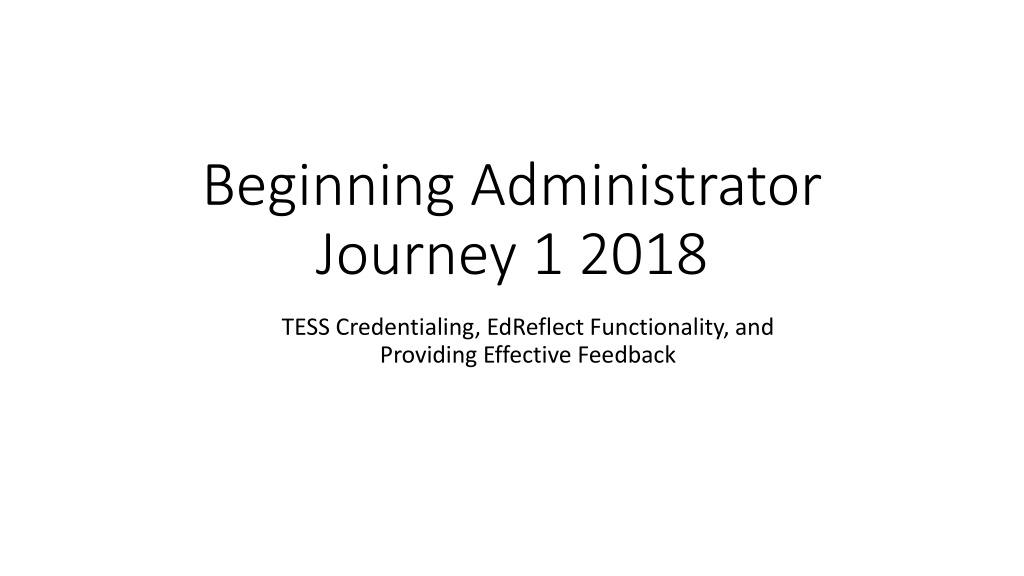
Effective Feedback Strategies for Beginning Administrators
Explore the journey of beginning administrators in acquiring TESS credentialing, utilizing EdReflect functionality, and providing effective feedback to teachers. Learn about establishing norms, planning, deconstructing the TESS framework, and more for professional growth.
Download Presentation

Please find below an Image/Link to download the presentation.
The content on the website is provided AS IS for your information and personal use only. It may not be sold, licensed, or shared on other websites without obtaining consent from the author. Download presentation by click this link. If you encounter any issues during the download, it is possible that the publisher has removed the file from their server.
E N D
Presentation Transcript
Beginning Administrator Journey 1 2018 TESS Credentialing, EdReflect Functionality, and Providing Effective Feedback
Objective Establish norms Plan for the Beginning Administrator Quest Review of rules new language Direct/Indirect EdReflect Functionality/Schedule PGP/Additional Artifacts Deconstructing the framework for TESS Identifying quality evidence Tagging/Rating evidence Lunch break 11:30 AM 12:00 Noon Providing Teacher Feedback Survive and Thrive Document Q & A
Norms Pull your own happy wagon Take care of your personal needs when necessary Silent Cell Phones and limit cell phone interruptions Stay actively engaged Limit sidebar conversations
Beginning Administrators Ready to Lead!! UP Stepping Journey 2: Principal Impact - Climate and Culture Instructional Practices: Follow-up discussion (QA- on observer tools, quality evidence, tagging, rating, feedback) Creating a Positive School Climate Impacting the Culture focusing on student learning and staff morale Cycle of Inquiry - School Improvement Plans where does Indistar fit? GPS Dashboard, ASIS Student Success Plans Guy Fenter Coop October 8 Wilbur Mills Coop October 11 Crowley s Ridge Coop October 12 Dawson Coop October 15 Southeast Coop October 18 AAEA Make-up October 19
Beginning Administrators Ready to Lead!! UP Stepping Journey 3: Measuring Success Instructional Practices: Standards Assurance eSchool Master Scheduling Discipline Attendance Teacher/Employee Fair Dismissal Student Disciplinary Hearing procedures Arch Ford Coop November 15 Northwest Coop November 13 Crowley s Ridge Coop November 16 Southwest Coop November 27 Arkansas River Coop November 29 AAEA Make-up Session November 30
Beginning Administrators Ready to Lead!! UP Stepping Journey 4: Wrapping it Up! Instructional Practices: End of Year Process and Procedures for EdReflect and Teacher Formatives and Summatives PLC Professional Learning Communities -Collaborative Teams structure for success -Working on the right work -Setting norms and monitoring the work Course Approval Process Questions and Answers on just about anything you want to discuss or brainstorm to problem solve End of Year Feedback Guy Fenter January 22 Wilbur Mills January 24 Crowley s Ridge Coop January 25 Dawson January 28 Southeast February 1 AAEA Make-up Session November 30
Nobody wants to be a Principal https://www.youtube.com/watch?v=tChhhKcGooI
Act 295 of 2017: Whats New Multiple Measures Multiple measures used as evidence of teacher practice: direct observation, indirect observation, artifacts, data Student growth demonstrated through multiple measures using artifacts and evidence embedded throughout the domains and not just one component Teachers may be placed in intensive support status if necessary; decision based on multiple measures 2017- 18 8
Act 295 of 2017: Whats New Feedback Summative rating at least once every four years No overall rating required in formative years; teacher and evaluator collaborate on PGP No domain level ratings required All evidence contributes to ONE overall summative rating 2017-18 9
Types of Evidence Types of Evidence Direct Observation Indirect Observation Artifacts Data The evaluator is physically present in the school or venue where the school/district teacher or leader is present, leading and/or managing The evaluator is observing systems that operate without the teacher or leader present Materials that document the school/district teacher or leader s practice Teacher and student performance data, student performance data, overall school performance data Examples: Examples: Examples: Examples: 2017-18 12
CLARIFICATION ON BLOOMBOARD & EdReflect ACCOUNTS Bloomboard.com: Think Bloom with resources! EdReflect.com Think Reflect on my pgp, observations, and summative eval with my principal AND reflect with my novice teacher on the informal mentor meetings, in-class coaching sessions, and micro-credential meetings.
EdReflect Functionality Follow along with me as we move through the system Observer/Learner dashboards work in both Scheduling events Collecting Evidence, tagging and rating Sharing with the teacher Writing LEADS PGP Goals Creating a self-assessment The work of the PGP for the observer Providing feedback
EdReflect Functionality Go to your observer dashboard Follow along with me as I move through the system https://edreflect.com/FromMarketplace/dashboard
Effective Observer On a 1-4 scale with 4 being most effective, where would you rate yourself on being an effective observer? Skills of an Effective Observer Unbiased leaves little to perception or interpretation Observant ---Environment, st/st, st/tchr (focused on what you see and hear in the classroom Look for Patterns and Trends Instructional Practices Strategic matches to the objective and st needs Seek to understand strategy Track quantities numbers over words, frequencies, distributions, pacing, checklists, tallies, seating charts used to track Write verbatim Ask sts about expectations ask lots of questions when appropriate
Deconstructing the Framework We participate in a framework study to deepen our knowledge of the expectations required to master the craft of teaching. When we can clearly articulate what teaching looks like at each proficiency level and between between proficiency levels, then we can: at each Write quality goals; Collect quality evidence; Provide actionable feedback; Select aligned resources and Develop shared understanding among colleagues and engage in meaningful conversations about practice.
Understanding the Component You can name key skills enhancing to move through the proficiency levels of this component. key skills a teacher is building and You can name student behaviors student behaviors demonstrated across the proficiency levels of this component. You can name the evidence for/teacher would gather to demonstrate proficiency with this component. (classroom, planning process, instruction) evidence an observer would look
Evidence.is a reporting of the facts. It may include statements, actions, or behaviors. It may also include artifacts prepared by the teacher, students, or others. Verbatim scripting of teacher or student comments; capturing the interaction between teacher/student; student/st.: Could one person from each table collect materials? Non-evaluative statements of observed teacher or student behavior: The teacher stands by the door, greeting students as they enter. Numeric information about time, student participation, frequencies, distributions, pacing, resource use, etc.: Three students of the eighteen offer nearly all of the comments during discussion. An observed aspect of the environment: what is occurring in the classroom behaviors or details of room The assignment is on the board for students to do while roll is taken. It is not personal opinion or bias. Leaves little to perception, focused on what you see or hear in the classroom. Quantitative Numeric information about time, student participation, resource use, tallies, pacing Numbers emphasized instead of words Qualitative Observed aspect of the classroom environment Verbatim scripting Non-evaluative statement of observed teacher or student behavior
Levels of Performance Unsatisfactory Basic Proficient Distinguished Progressing Ineffective Highly Effective Effective Understands the FfT and is actively attempting to apply it. Understands the FfT and is actively attempting to apply it. Understands the FfT and is actively attempting to apply it. No evidence of understanding of the FfT Uneven, inconsistent results when observed. Consistent results when observed. Consistent results when observed. Unaware or Don t Care Some Attempts to Limited Moderate Uneven Inconsistent Rudimentary ALL Students Most Students Doing Harm Not No Not clear Unaware Does not respond Poor Not congruent Students Contribute to classroom operations Consistent High quality Timely Accurate Appropriate Clear Effective High expectations All students Highly effective Entirely appropriate Adapted for individual students Fully aligned Extensive TESS Defining Danielson 20
3C. Engaging Students in Learning Locate the rubric Open the window to look at the different levels of proficiency
Look at some examples. Content wall placed at the front of the room including language of the discipline, definitions, and examples of the words in context. Tchr: What is influencing Joey s behavior in this chapter? St: His friend s peer pressure. Tchr: How do you know? What evidence can you provide from the text? The teacher sets the timer for 5 minutes as the students enter the door. Keep an eye on the time we ll start correcting in 5 minutes. Students are working in groups of 3. Students turned their chairs so they are facing each other as they talk.
How might you change these statements? You are clearly passionate about your subject! Teacher had to redirect the students attention to the task multiple times. Students appear on task from the moment they walk in the door. Good use of questioning to drive deep thinking. Student groups are conducive to the task.
3C Engaging Students in Learning Center piece all other components contribute to it Challenging content Students are developing an understanding through what they do Debate, What if?, Discovering patterns Beginning, middle, and an end with scaffolding Tasks are cognitive challenge Students are encouraged to reflect Closure to the lesson What are the students being asked to do? Best evidence of engagement what students are saying and doing as a consequence of what the teacher does, has done, or has planned.
3C - Elements Activities and assignments What students are asked to do Requires student thinking Emphasize depth Allows student choice Groups of students Student grouping to maximize student engagement (also an element of 2C: Managing classroom procedures) Instructional materials and resources Structure and pacing Not bored or risk in completing task Keeping things moving A time for reflection and closing
3A Communicating with Students Think about and consider Teaching and learning are purposeful activities Provide clear directions Presentations are accurate, clarity, and imagination Embellish explanations with analogies, metaphors, linking to student interests and prior knowledge Use of language is vivid, rich, and error free Scaffolding and access to all students
3A Elements Expectations for learning (business-like) Goals clearly communicated Students clear about what they are learning Clarity of lesson purpose Directions and procedures Expectations are clear Explanation of content Explanations are clear Absent of content errors Use of oral and written language Teacher s use of language is student s best model for accurate syntax and rich vocabulary Correct and imaginative use of language
Video Scripting/Tagging/Rating Practice Principals open an informal observation in EdReflect and either use notes or Quickfire to collect evidence during the video At the end of the video principals will take time to reflect and ensure quality evidence Have principals provide a rating for component and keep private Ask principals with basic rating to stand and justify rating; continue with proficient and distinguished Give the master rating score and discuss Have principals share evidence with a partner and discuss differences
When observing a teacher in your building what are you looking for . Do you go in only looking for and documenting 3A/3C like we just did in the video practice? Partner-up --Open rubric 3A video what evidence can you find other than 2C, and what might you rate it? Switch partner 3C video - what evidence can you find other than 2C, and what might you rate it? Component Connections handout
Providing teacher feedback Invite reflection Reflective Planning Conversations Tied to specific teaching standards/PGP Constructive, with effective use of questioning Justin Baeder s 10 Questions Specific, detailed and evidence based Timely and frequent Comments attached to individual pieces of evidence Comments attached to ratings Feedback and Next Steps Identify specific and actionable next steps Offer appropriate resources/supports Deconstruct the component with the teacher Let the evidence speak
4 Functions: Cognitive Coaching Coaching transforming one s thoughts to change behavior, support self-directive Collaborating forming and reforming Consulting informing (make thinking visible think aloud), offer a menu of options, reference current research Evaluating process of conforming to external factors that have be agreed upon -From the video watched -Feedback conference -Partner up one role models the teacher and one the principal -Add a third person to the pair so that this 3rd person listens and then coaches and provides guided conversation about what they heard during the role play
5 Forms of Feedback Judgement Comments that place value (good or bad) on something. That was a great lesson today. Personal observations Opinions, advice, suggestions. I am disappointed in the choice you made with the consequences for him. Inferences Non-specific, have to read between the line. Our team isn t able to make a decision and move forward because what you ve left undone. Your classroom was engaging. Data Show, don t tell the data, use quotes. You talked for 8 minutes. Mediative Questions Requires thinking, an invitation, positive, an intention. How did you decide what directions to give and how much time to give your students to talk? Who might you be able to call on to assist you? What might influence your decision? What would be your goal in this change? How would you know you are successful? Why do you want to do this? So after learning this and reflecting how are you feeling?
Feedback Process Reflection question Listen Paraphrase Pose new question Analyze question - Based on what you said you learn, what are your next steps or goals for your next lesson in which you decide to use these same activities? Listen Paraphrase Pose new question New learning question - After reflecting on your instruction and the activities you chose, and then analyzing why you think they were not successful, what did you learn? Listen Paraphrase Pose new question Goal or steps for the future question - Based on what you said you learn, what are your next steps or goals for your next lesson in which you decide to use these same activities? Listen Paraphrase Pose new question
Reflection Questions Could be open and broad: Reflecting on your lesson that I observed, how do you think your instruction and student engagement went? How do you think the lesson went? How are you feeling about ? Could be goal specific: Reflecting on your goal_______, and your lesson that I observed, how do you think you are progressing on______? Could be component specific: Reflecting on your lesson that I observed, how do you think the transition strategies you chose to use today went? How do you feel about the level of student engagement in today s lesson? Reflecting on your lesson and your goal of increasing and improving on your questioning strategies, how do you think you did with the questions you asked during the lesson today?
Analyzing questions Why do you think the activity you chose to teach this concept did/or did not increase student engagement? What effect do you think your transitions had on your lessons and classroom procedures today? How do you know? What comparisons might you make between the lesson you taught and the one you planned or envisioned? What are you hunches about what caused ? What effect did your decisions have on the results .? New Learning: After reflecting what have you learned? Next Steps/Goals for the future: After your reflecting and what you have learned, what are Your goals or next steps?
Data Reported to the ADE Data Reported to the ADE Aggregate School Ratings TESS Only Total Number of Teachers Total Number Proficient/Distinguished % Proficient/Distinguished No individual educator data For the 2018-19 school year (pending approval of AR ESSA Plan) report to the ADE only, number of ineffective teachers Aggregate State Ratings TESS (% Not Meeting Standard, Progressing, Effective, Highly Effective) Overall Ratings LEADS (% NMS, Progressing, Proficient, Exemplary) no school level ratings Overall Ratings 20127-18
Are You TESS/LEADS Ready? Are You TESS/LEADS Ready? Teacher Training Training on Danielson s Framework for Teachers is established at the school/district level Decisions about on-going training should be based on previous evaluations, professional learning, and/or a needs assessment Remember: New teachers must be trained in the evaluation system to be used. Use care in omitting component training 2017- 18 37
Best Practices of Implementation Best Practices of Implementation It is all about support for teachers and leaders Be aware of school/district evaluation policies, as many decisions are made locally Learn the rubric content; let it become the language of your communication Learn from your professional networks and other experienced educators Plan and implement with fidelity Remember The Arkansas Teacher Fair Dismissal Act of 1983, codified at ArkansasCode. Annotated section 6-17-1501 et seq. 2017-18
The Power of Teamwork https://www.simpletruths.com/motivational-teamwork-videos.html How does your team function? How could you use this video with your campus leadership team to emphasize the importance of teamwork? How might the CLT members then use this video to encourage conversation with their respective departments or grade levels? Who Moved My Cheese? https://www.youtube.com/watch?v=hlBD4vJsPzo As the new principal you are the new cheese .. How can you use this short read or this video with your faculty to begin the discussion of accepting change, getting on-board and contributing positively to the change. Survive and Thrive ADE BA Webpage http://www.arkansased.gov/public/userfiles/Educator_Effectiveness/BA/Survive_ and_Thrive_Resource_June_2018.pdf
Books that have influenced my practice Make time to read! The Collaborative Administrator Solution Tree (DuFour, Eaker, plus 13 other contributors) You Have to Go to School-You re the Principal 101 Tips Paul Young The Principal Three Keys to Maximizing Impact Michael Fullan The Principal Survival Guide Kessler, Snodgrass, Davis FISH Stephan Lundin, John Christensen, Harry Paul, Ken Blanchard Who Moved My Cheese? Spencer Johnson Monday Morning Leadership David Cottrell On Common Ground- Richard DuFour The Leader In Me Steven Covey Grading Smarter not Harder Rick Wormeli Poverty Matters Tammy Pawloski Teach Like a Pirate David Burgess The Passion Driven Classroom Angela Maiers Mindset Carol Dweck
Good to Great Jim Collins School Cultured Rewired Steve Gruenert & Todd Whitaker Dealing with Difficult Teachers- Todd Whitaker The Confrontational Parent Charles Jaksec III Confidence Rosabeth Moss Kanter Failure is Not an Option Alan Blankstein Principals should Know and Be Able to Do NAESP Creating a Love and Logic School Culture Jim Fay Inspiring the Best in Students Jonathan Erwin The Power of A Teacher Adam Saenz Motivating Students Who Don t Care Allen Mendler The Inspirational Teacher Gary McGuey Attitude is Everything Keith Harrell
The Energy Bus Jon Gordon A Whole New Mind Daniel Pink A Complaint Free World Will Bowen Move Your Bus Ron Clark ZAPP! In Education William Byham Leaders of Learning Richard DuFour The 7 Habits of Highly Effective People Stephen Covey The five Love Languages of Teenagers Gary Chapman First Things First Stephen Covey Motivating Black Males to Achieve Baruti Kafele Leadership Matters Lee Colan Getting to Got It! Betty Garner What Works in Schools Robert Marzano School Leadership that Works Robert Marzano
Websites: Great Schools - GreatSchools-Newsletters@email.greatschools.org Lead Your School - leadyourschool@multibriefs.com ASCD - ascd@smartbrief.com The Principal Center - https://www.principalcenter.com Cult of Pedagogy - gonzjenn@cultofpedagogy.com Education Week - http://www.edweek.org Smart Brief on Special Education - specialed@smartbrief.com Simple Truths - https://www.simpletruths.com/ School Leaders Now - https://schoolleadersnow.weareteachers.com/classroom- management-strategies-principal/#.WZGeNlGGPIH GPS Dashboard - https://adeedfidemo.arkansas.gov/Dashboard_STS/Login.aspx Indistar School Improvement Plan- http://www.indistar.org/
Reflection What did I learn today that will improve my practice? What are two things I ll will do differently over this next month based on what I learned today? I need more training or support in __________________________area.
ADE Division of Educator Effectiveness and Licensure ADE Division of Educator Effectiveness and Licensure Dr. Jeremy Owoh, Assistant Commissioner Jeremy.Owoh@Arkansas.gov Sandra Hurst, Division Director Sandra.Hurst@Arkansas.gov Rocci Malone, Leadership Development Coach roccimalone@gmail.com Rocci.Malone@searkcoop.com 972-983-7540 or 479-965-4874 Mike Hernandez, State Superintendent Mike.Hernandez@Arkansas.gov Sheila Whitlow, State Asst. Superintendent Sheila.whitlow@Arkansas.gov



